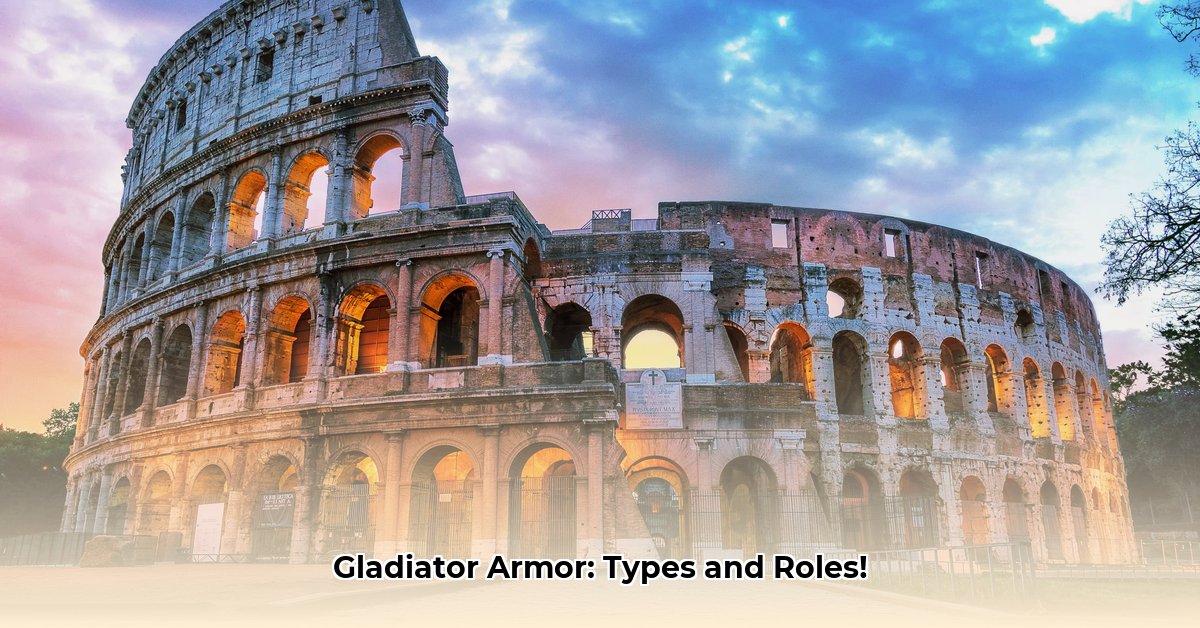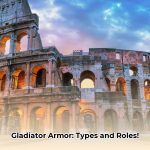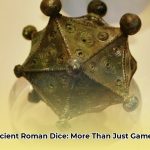Step into the roar of the Colosseum, where ancient Roman gladiators were far more than mere fighters; they were meticulously equipped performers, their very survival often hinging on the calculated design of their armor and weapons. The gladiatorial arena was not a chaotic free-for-all but a strategically designed spectacle, with each combatant’s gear crafted to create captivating, often deadly, matchups. This comprehensive guide delves into the intricate world of Roman gladiator armor, exploring how each piece, from helmet to greave, contributed to unique combat roles, tactical advantages, and the enduring drama of the amphitheater.
The Armored Fighters: Gladiator Archetypes and Their Signature Gear
Gladiators were classified into distinct armaturae, or fighting styles, each defined by a specific combination of weapons and defensive equipment. This system was vital for creating the “fair play” that Roman audiences demanded, pitting contrasting strengths and weaknesses against one another to amplify the spectacle. The underlying philosophy often involved balancing heavy defense with agility, ensuring no single type was inherently invincible.
The Heavily Armored: Tanks of the Arena
These gladiators embraced robust protection, often sacrificing speed for formidable defense and powerful, direct assaults.
Murmillo: Often considered the “fish-man” due to the distinctive fish-fin crest on his helmet (cassis crista), the Murmillo was a heavily armored warrior. He wielded a gladius (short sword), a large rectangular scutum (shield), a manica (arm guard, typically on his sword arm), and an ocrea (metal greave) on one leg. His style was one of brute force and powerful, frontal charges, making him a formidable opponent, often paired against the agile Retiarius or the quick Thraex. The Murmillo’s helmet, with its small eye slits, offered significant protection but limited his peripheral vision.
Secutor: Known as the “chaser” or “pursuer,” the Secutor was often armed almost identically to the Murmillo, carrying a gladius, a large scutum, a manica, and an ocrea. His most distinctive feature was his smooth, rounded helmet, specifically designed to prevent the Retiarius’s net from catching on protrusions. This helmet had only two small eyeholes, which, while protective, severely restricted vision and airflow, making exhaustion a constant threat. The Secutor was almost exclusively pitted against the agile and lightly armored Retiarius.
Samnite: Named after Rome’s formidable early enemies, the Samnite was one of the oldest and most heavily armed gladiator types. His gear included a large oblong scutum, a gladius or spear, a plumed galea (helmet) with a visor, manicae (leather elbow or wristbands), and greaves. As the Samnites became Roman allies, this gladiator type evolved, and the name “Samnite” was largely dropped in favor of types like the Secutor and Murmillo, which retained similar equipment but avoided politically sensitive national labels.
Hoplomachus: Their name translates to “armored fighter,” and their equipment strongly resembled that of Greek hoplites. The Hoplomachus wore a helmet with a visor, bore a distinctive small, round shield called a parmula, and fought with a short spear (hasta) and a short sword or dagger (pugio). They also wore manicae on their right arm and long greaves on both legs, offering a balanced mix of defense and offensive reach.
The Lightly Armored: Masters of Agility and Cunning
These gladiators capitalized on speed, agility, and unique weapons to outmaneuver their more heavily armored counterparts.
Thraex (Thracian): Named after yet another enemy of Rome, the Thraex was designed for swift, unencumbered combat. He carried a small rectangular or round shield (parmula) and a distinctive curved scimitar-shaped dagger known as a sica, ideal for slicing and thrusting attacks to bypass an opponent’s shield. The Thraex also wore two high greaves, a manica, and a helmet with a griffin crest. They were frequently matched against the Murmillo, a classic pairing of speed versus strength.
Retiarius: The “net-man” was perhaps the most distinctive and lightly armored gladiator. Eschewing a helmet, shield, and most body armor, the Retiarius relied on speed, cunning, and unique tools: a weighted rete (net) to entangle opponents, a three-pronged tridens (trident) like a fisherman’s spear, and a small dagger (pugio) for close combat. His only protection was a galerus (metal shoulder guard) on his left shoulder and a manica on his left arm. The Retiarius’s fighting strategy centered on ensnaring his opponent from a distance before moving in for the kill. They most commonly fought the Secutor and Murmillo.
Provocator: Meaning “challenger,” the Provocator initially resembled a Roman legionnaire. Later, they became known for a distinctive rectangular or crescent-shaped breastplate called a cardiophylax, worn over a loincloth, along with a galea (helmet) featuring a distinctive brim and circular eye grates, a manica, and a large scutum. Provocatores almost exclusively fought against other Provocatores, providing a relatively evenly matched contest of skill.
Equites: These were the gladiator cavalrymen, fighting on horseback, usually against each other. Lightly armed, they wore a brimmed helmet adorned with decorative feathers (but no crest), a tunic instead of a loincloth, and carried a medium-sized round shield (parma equestris) and a sword or spear. Battles often began mounted, continuing on foot if one was unseated.
Dimachaerii: Known as “two-knife men,” these gladiators fought with two short siccae (scimitar blades), one in each hand. Their armor was minimal, often consisting of just a loincloth and belt, showcasing their reliance on speed and dual-wielded offense.
Anatomy of Defense: Essential Gladiator Armor Pieces
Beyond the specific archetypes, several common pieces of armor formed the core of a gladiator’s defensive kit, each with its own Latin name and specialized function:
- Galea (Helmet): The most recognizable piece of gladiator armor, offering vital head protection. Galeae varied greatly in design, from the smooth dome of the Secutor’s helmet to the elaborate crests (like the Murmillo’s fish or Thraex’s griffin) and visors. Eyeholes were typically small, limiting vision but increasing protection.
- Manica (Arm Guard): A crucial piece for protecting the striking arm, the manica was a segmented guard made of leather, padded linen, or metal scales/rings. It provided flexibility while shielding against blows and cuts, ensuring a gladiator could continue to wield their weapon effectively.
- Ocrea (Greave): Metal shin guards that extended from the ankle to just below the knee, or sometimes even up to the thigh. Ocreae were designed to protect the lower legs from strikes, preserving a gladiator’s mobility, and were sometimes worn on both legs or just the leading leg, depending on the gladiator type.
- Scutum (Large Shield): A large, oblong, semi-cylindrical body shield, similar to those used by Roman legionaries. Made of multiple layers of wood, covered in leather or canvas, the scutum (around 40 inches tall and 16 inches wide, weighing about 22 lbs or 10 kg) provided extensive body protection and was used by heavily armored gladiators like the Murmillo, Secutor, and Samnite. It could also be used offensively for pushing and striking.
- Parmula (Small Shield): A smaller, lighter shield (around 36 inches in diameter), typically round but sometimes rectangular. Used by more agile gladiators like the Thraex and Hoplomachus, the parmula offered less coverage than the scutum but allowed for quicker movements and deflection.
- Galerus (Shoulder Guard): A distinctive metal shoulder piece, often crescent-shaped, worn primarily by the Retiarius. This guard protected the exposed upper arm, shoulder, and part of the neck and head, deflecting blows that might otherwise strike the lightly armored Retiarius.
- Cardiophylax (Breastplate): A small breastplate, usually rectangular or crescent-shaped, made of bronze. This was a unique piece of torso armor almost exclusively worn by the Provocator, covering the chest area.
- Subligaculum (Loincloth) and Balteus (Belt): These were standard undergarments. The subligaculum was a simple loincloth, fastened by a broad leather balteus (belt) which could hold a sword or dagger and sometimes featured decorative metal plates for added waist protection.
- Fasciae (Protective Padding): Cloth or leather pads worn around the legs and arms beneath the metal armor, providing cushioning and additional protection against chafing and glancing blows.
The Gladiator’s Dilemma: Mobility, Protection, and Survival
The design of gladiator armor was a masterclass in strategic trade-offs. The choice between robust defense and essential agility directly influenced a gladiator’s fighting style, their chances of victory, and ultimately, their survival within the brutal confines of the arena.
The Weight-Agility Paradox
Heavier armor, while offering superior protection, imposed significant limitations. Gladiators like the rare Crupellarius, who wore almost a full suit of heavy iron armor (effectively becoming a walking tank), sacrificed almost all mobility. They were rapidly exhausted and often easily dispatched once their limited movement became a hindrance. Conversely, lighter armor, as seen on the Retiarius, granted immense agility and speed but left critical areas vulnerable. Every gladiator faced this paradox, adapting their combat techniques to leverage their gear’s strengths while mitigating its inherent weaknesses.
Case Study: Secutor vs. Retiarius – A Dance of Contrasts
The iconic duel between the Secutor and Retiarius perfectly encapsulated this dynamic. The heavily armored Secutor, nicknamed the “chaser,” would relentlessly advance, relying on his smooth helmet to deflect the Retiarius’s net and his large scutum for protection. His strategy was to close the distance quickly and engage in powerful close-quarters combat. The lightly armored Retiarius, on the other hand, depended entirely on his superior speed, agility, and the element of surprise. His primary objective was to quickly entangle his opponent with the net from a distance, immobilizing him, before moving in for the decisive strike with his trident or dagger. This captivating pairing highlighted the dramatic tension of the arena: the Secutor had to finish the fight swiftly before exhaustion from his heavy armor overwhelmed him, while the Retiarius had to act decisively with his net before his lack of defense proved fatal up close.
Training for Survival: Beyond the Armor
Gladiators underwent rigorous training at specialized schools (ludi gladiatorius) overseen by a lanista. Each gladiator type had a doctor (specialist trainer) skilled in that specific fighting form. Training wasn’t just about physical prowess; it was about mastering the unique attributes of their armaturae.
- Rudis and Palus: Gladiators initially trained with wooden weapons (rudis) that were heavier than their metal counterparts but blunted to minimize injury during drills. They honed their offensive and defensive techniques against a sturdy wooden training stake called a palus. This repetitive training built immense stamina and muscle memory, crucial for wielding heavy armor and weapons effectively in prolonged combat.
- Stamina and Strategic Energy Use: The weight of the armor directly impacted a gladiator’s energy expenditure. Heavily armored fighters had to be more careful with their movements, relying on precise, powerful strikes. Lightly armored gladiators could afford to move more, but their movements had to be swift and decisive to avoid being caught.
Beyond the Steel: Cultural and Economic Echoes of the Arena
The gladiator’s armor was more than just protective gear; it was a potent symbol, reflecting broader aspects of Roman society, conquest, and economics.
The Spectacle of Conquest
Many gladiator types, like the Samnite and Thraex, directly derived their names and often their equipment from groups that had been decisively defeated by Roman military might. This served as a powerful, living demonstration of Roman imperial victories, reminding the populace of Rome’s dominance. As these conquered peoples became integrated into the Roman Empire, the gladiator types also evolved. For instance, the politically sensitive names “Samnite” and “Gaul” were eventually replaced by terms like “Murmillo” and “Secutor” during the Principate, while retaining similar combat styles, reflecting a shift in Roman identity and political correctness.
Economic Realities: Gladiators as Investments
Gladiators were substantial financial investments for their owners, the lanistae. These trainers leased their gladiators for events, and the cost of replacing a gladiator










